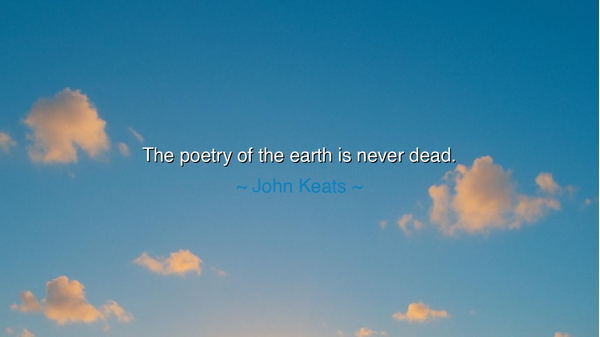
The poetry of the earth is never dead.






Hearken, children of the ages, and lend ear to the immortal words of John Keats, who beheld the natural world with the heart of a poet and the soul of a sage: "The poetry of the earth is never dead." Herein lies a meditation upon the eternal vitality and beauty of the natural world—a truth that transcends seasons, generations, and even the fleeting concerns of human life. Keats reminds us that the earth, in all its forms, sings a song of life and wonder, a symphony that endures through the cycles of creation and decay.
In these words, the poetry Keats speaks of is not confined to words or human artifice. It is the voice of rivers, the whisper of the wind through trees, the delicate unfolding of flowers, and the unceasing rhythm of day and night. Each element of the earth participates in a living verse, composed in a language older than man, yet ever accessible to those who open their senses and their hearts. Even in the harshest winters or the darkest nights, this poetry remains vibrant, awaiting the attention of the soul attuned to its music.
Consider the example of Rachel Carson, who devoted her life to studying and protecting the natural world. Through her writings, she captured the hidden poetry of ecosystems, from the smallest insect to the vast ocean currents. She reminded humankind that even the most overlooked creatures, the subtle rustle of leaves, and the intricate patterns of the soil are part of the earth’s ongoing verse. Carson’s life mirrors Keats’s insight: the poetry of the earth persists, and those who perceive it can translate its lessons into understanding, reverence, and action.
Keats’s statement also illuminates a deeper philosophical truth: life itself is sustained by the continuous renewal and interconnection of all things. A fallen leaf decays to nourish the soil; a river floods to enrich the plains; seasons turn with unerring precision. Even what appears lifeless is imbued with potential, with the latent energy that fuels growth, renewal, and beauty. To witness the poetry of the earth is to recognize that life never truly ceases, and that every element participates in the eternal narrative of existence.
Reflect also upon the works of the great landscape painters of the Romantic era, who sought to capture the sublime poetry of mountains, forests, and skies. Caspar David Friedrich, for example, painted scenes that evoke the infinite dialogue between the human spirit and the grandeur of nature. Through their brushstrokes, they demonstrated that the poetry of the earth is a language that speaks to courage, awe, and reflection, inspiring the observer to seek wisdom and humility in the face of creation’s majesty.
The lesson is profound: immerse yourself in the living poetry that surrounds you. Attend to the rhythms of nature, the play of light upon water, the chorus of birds at dawn, the silent majesty of stars at night. Recognize that the earth itself is a teacher, and that its poetry offers solace, inspiration, and guidance to those willing to listen. Life, like poetry, is woven from detail, rhythm, and attentive presence.
Practical action follows naturally: cultivate awareness and reverence for the natural world. Walk through forests, explore riversides, or simply watch the changing sky. Record your observations, reflect upon them, and let the earth’s poetry guide your understanding of connection, patience, and beauty. Engage with the world as Keats did—not as a mere observer, but as a participant in its ongoing, living verse.
Thus, John Keats’s words endure as both celebration and instruction: the poetry of the earth is never dead, for it courses through every leaf, every breeze, and every wave. Let us honor it, heed its lessons, and carry its eternal song within our hearts, so that our lives, too, may become harmonies in the grand, enduring symphony of the natural world.
If you wish, I can also craft a poetic, audio-ready version of this passage, where the rhythm mirrors the flowing, living poetry of nature, enhancing the emotional and meditative resonance of Keats’s vision. Do you want me to do that?






AAdministratorAdministrator
Welcome, honored guests. Please leave a comment, we will respond soon